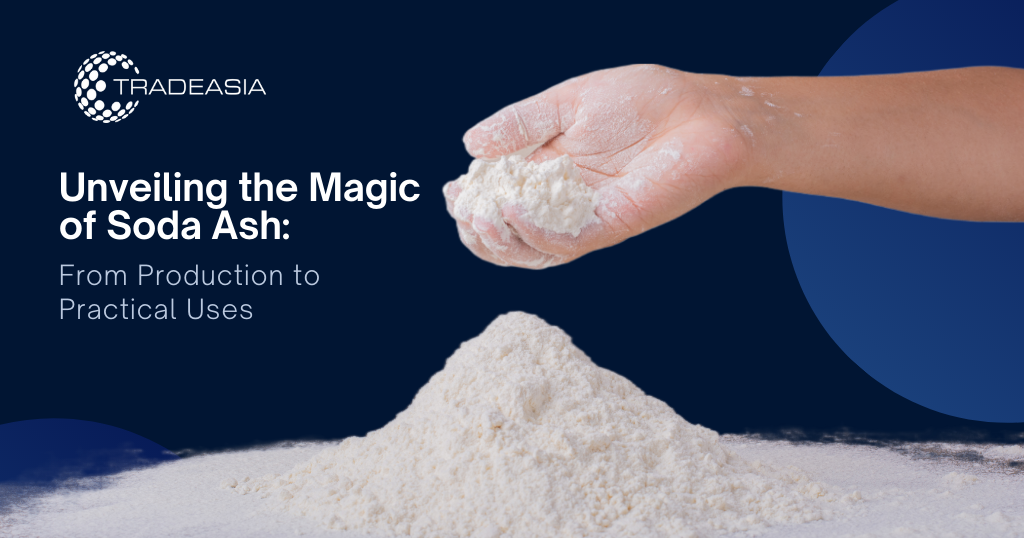Introduction
If you’re familiar with everyday products and their manufacturing processes, you might have come across the term “soda ash.” This versatile substance plays a significant role in various industries and products. In this article, we’ll dive into the world of soda ash, exploring its definition, production methods, uses, and more.
What is Soda Ash?
Soda ash, scientifically known as sodium carbonate (Na2CO3), is a versatile and essential chemical compound that finds its applications in various industries.It is a white, odorless powder with the chemical formula Na2CO3, consisting of two sodium (Na) atoms, one carbon (C) atom, and three oxygen (O). Soda ash has a wide range of applications, ranging from household cleaning to industrial manufacturing processes. In this article, we will delve into the properties, production, and diverse applications of soda ash.
How is Soda Ash Made?
Soda ash can be produced through two main methods: the Solvay process and the Trona ore method. The Solvay process, named after its Belgian inventor Ernest Solvay, is a widely used synthetic method for soda ash production. This process involves treating sodium chloride (salt) with ammonia and carbon dioxide to create sodium bicarbonate, which is then heated to produce soda ash. The Trona ore method, on the other hand, extracts soda ash from underground Trona deposits, which are dissolved and processed to obtain the final product.
Diverse Uses of Soda Ash
Soda ash finds its way into numerous industries. One of its most common applications is in glass manufacturing, where it lowers the melting point of silica, facilitating the production of glass products. Additionally, it’s a key component in the production of detergents, helping to soften water and enhance cleaning efficiency. Soda ash also plays a crucial role in water treatment, pH regulation, and even food processing.
1. Glass Manufacturing
One of the most notable applications of soda ash is in the production of glass. As a fluxing agent, soda ash reduces the melting point of silica (the main component of glass) during the glassmaking process. This reduction in melting point makes it easier to shape glass into various forms such as bottles, windows, and even intricate glassware. Additionally, soda ash aids in maintaining the clarity and stability of glass products.
2. Detergents and Cleaning Products
Soda ash plays a vital role in the detergent industry. It is used as a builder, enhancing the effectiveness of cleaning agents by softening water and allowing the detergent to lather more effectively. This property makes it easier for detergents to remove dirt, stains, and grease from fabrics, dishes, and surfaces.
3. Water Treatment
In the field of water treatment, soda ash is employed for both pH adjustment and water softening. As an alkaline substance, soda ash is added to water to raise its pH levels, neutralizing acidity and making it less corrosive. Moreover, it aids in water softening by precipitating calcium and magnesium ions responsible for water hardness, thus improving the quality of water used in various industrial and domestic applications.
4. pH Regulation in Various Industries
Soda ash’s alkaline nature makes it a valuable tool for pH adjustment in a range of industries. It is used in textile dyeing and finishing to control the pH of dye baths, ensuring proper color fixation and vibrant results. In the food industry, soda ash regulates acidity levels in certain food products, contributing to the taste and texture of items like baked goods and beverages.
5. Metallurgy
In metallurgical processes, soda ash serves as a fluxing agent, aiding in the removal of impurities from ores during the smelting and refining of metals. It helps in forming slag, which encapsulates impurities, allowing them to be separated from the desired metal.
6. Paper and Pulp Industry
Soda ash finds its way into the paper and pulp industry, where it helps maintain the pH levels during various stages of paper production. By controlling the pH, soda ash assists in the optimization of paper properties and contributes to the overall quality of the final product.
7. Chemical Manufacturing
Soda ash’s reactivity with acids is harnessed in various chemical processes. It is used to neutralize acidic substances, producing salts and water. This property is essential in industries such as chemical manufacturing, where precise pH control is crucial.
8. Food Processing
In the food industry, soda ash is utilized for diverse purposes. It can be used to regulate acidity in food products, act as a leavening agent in baking, and even enhance the texture of certain foods.
9. Textile Industry
Soda ash plays a role in the textile industry by facilitating dye fixation and enhancing the color quality of fabrics. It assists in the dyeing process, ensuring that the dye molecules effectively bond with the textile fibers.
Other Names for Soda Ash
Soda ash is known by several other names, including “washing soda” and “sodium carbonate.” These names are often used interchangeably depending on the context.
“Washing soda” reflects its historical use in laundry and common term used for soda ash, particularly in household and cleaning contexts. This name stems from its historical use as a laundry aid, where it was added to water to enhance the cleaning power of soaps. Washing soda effectively softens water, allowing detergents to work more efficiently in removing stains and dirt. The scientific name for soda ash is sodium carbonate.
This name is derived from its chemical composition: sodium (Na), carbon (C), and oxygen (O). It is the most precise and widely recognized term, especially in scientific and technical discussions.
Conclusion
While “soda ash” remains the most widely recognized and used term, the various alternative names reveal the compound’s diverse applications and historical associations. From cleaning to textile dyeing, from chemistry to industrial manufacturing, soda ash goes by many names, each highlighting a different facet of its importance. Understanding these alternative names helps us appreciate the compound’s versatility and the role it plays in shaping our modern world.

